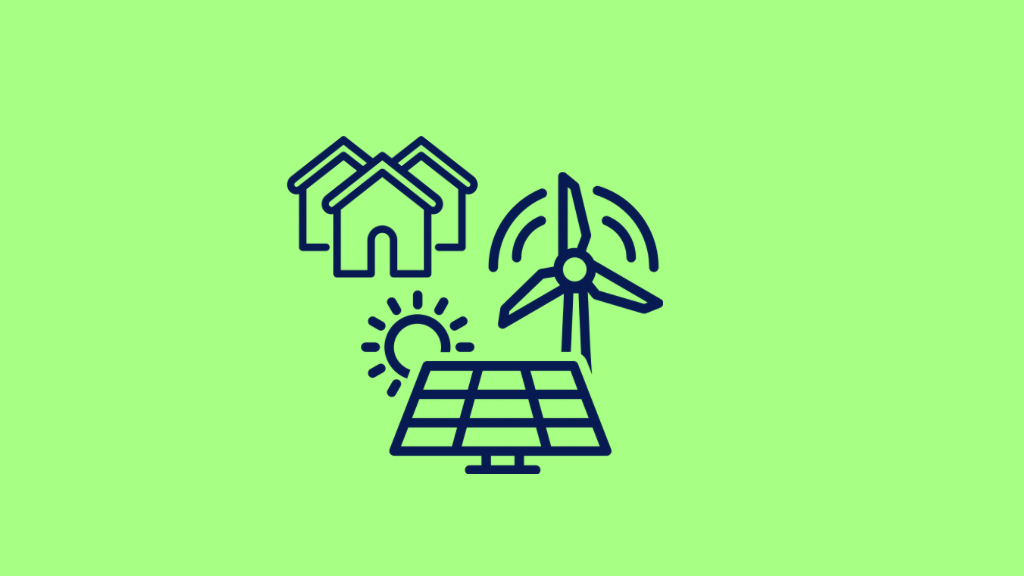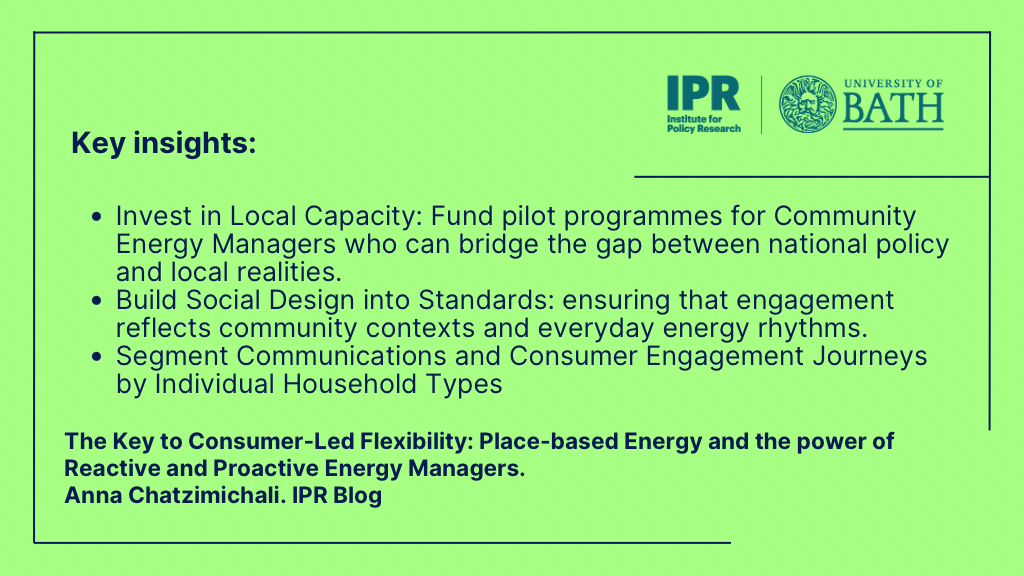The UK’s ambition to achieve a clean power system by 2030 and net zero by 2050 depends on a more flexible electricity system. Consumer-Led Flexibility (CLF), where households and businesses voluntarily shift electricity use to times when energy is abundant, plays a central role to play. The government’s Clean Power 2030 Action Plan calls for a four- to five-fold increase in CLF capacity by 2030.
But here’s the challenge: CLF is voluntary. It relies on consumers being informed, motivated, and willing to participate. And that means engagement strategies must go far beyond apps, tariffs, and technical fixes. Drawing on a recent policy consultation on “Unlocking Community Energy at Scale,” led by Dr Anna Chatzimichali, we highlight the vital role of strong social relationships in enabling flexible energy use. This work builds on findings from the EPSRC-funded project GLOW (EP/V041770/1), led by Professor Oliveira (University of Strathclyde), with co-investigators Dr Chatzimichali (University of Bath), Dr Adkins (University of Bristol), Dr Perez Hernandez, and Dr Badarnah (University of the West of England).
The Engagement Gap
The recent government consultation on consumer engagement for CLF recognises the risks of continuing with a fragmented, market-led approach to distribute energy. However, without a clear coordination, consumers face a confusing landscape of jargon-heavy offers, inconsistent standards and unclear benefits. Often, people do struggle to understand what flexibility means and how it benefits them, with many households unable to see how CLF links to net zero or energy security. Some fear flexibility means sacrificing comfort or convenience with low-income and digitally excluded households being at risk of remaining left behind.
The consultation proposes four core functions for an engagement framework:
- Coordination – to ensure consistency and coherence across industry.
- Standards – to build trust and protect consumers.
- Advice – to provide clear, neutral information.
- Communications – to raise awareness and drive uptake.
These are essential steps. But they are not enough.
What Our Research Shows
Our research, funded by EPSRC under the GLOW project, reveals that energy flexibility is not just a technical or economic decision, it is deeply social. Household participation is shaped by social identity, community belonging and everyday routines. In our work we identified two broad household profiles:
- Proactive energy managers: Motivated, socially connected, and willing to experiment or shift energy consumption, especially when they feel part of a community effort.
- Reactive energy managers: Prioritise comfort and convenience, engaging only when prompted and when the process is simple.
Crucially, households with strong community ties are far more likely to adopt flexible behaviours. They see energy actions as part of a shared purpose, not just an individual trade-off. In contrast, those who feel disconnected from their community often view energy management as “someone else’s problem.”
This means that engagement strategies focused solely on price signals or digital tools will fail to reach large segments of the population. To succeed, CLF must feel relevant, trustworthy, and socially meaningful.
A Fifth Function: Place-Based Energy Culture
Based on the research the CLF should also add a cross-cutting function to the engagement framework: Place-Based Energy Culture.
This function would:
- Activate local advocates: Create “Community Energy Managers” embedded within local authorities to champion flexibility.
- Foster peer-to-peer support: Enable neighbourhood networks to share experiences and support vulnerable households.
- Co-design consent and energy literacy journeys: Tailor these to household routines and cultural norms.
Why does this matter? Because energy behaviours are embedded in daily life: school runs, meal times, payday cycles - not in abstract price curves. A place-based approach ensures that engagement strategies resonate with real-world rhythms and values.
Practical Steps for Policy and Industry
- Invest in Local Capacity
Fund pilot programmes for Community Energy Managers who can bridge the gap between national policy and local realities. - Build Social Design into Standards
Move beyond technical compliance to “standards-by-social-design,” ensuring that engagement reflects community contexts and everyday energy rhythms. - Segment Communications and Consumer Engagement Journeys by Individual Household Types
- For proactive households: Highlight community benefits and opportunities to support.
- For reactive households: Emphasise comfort safeguards and simplicity.
Why This Matters Now
The government’s consultation rightly warns that without a joined-up approach, the CLF market could become fragmented and confusing, undermining trust and slowing uptake. But the risk is not just technical, it is primarily social.
If engagement strategies ignore identity, belonging and local context, we risk designing a system that works for the digitally savvy few while leaving others behind. That would not only be inequitable and would jeopardise our ability to deliver a flexible, resilient energy system at the scale and speed required. Embedding social and cultural dimensions into the CLF engagement framework should not be an afterthought, but a critical enabler of net zero.
This blog highlights recent research by Dr Anna Chatzimichali and her colleagues. Recent work includes Atkins, E., Moldovan-Nazari, L., Oliveira, S., & Chatzimichali, A. (2025). The rhythms and rhythmanalysis of household energy demand. Environmental Research: Energy, 2(2), 023001 and Oliveira, S., Chatzimichali, A., Bagheri-Moghaddam, F., Atkins, E., & Badarnah, L. (2025). The hidden work of everyday decisions in the home-Domestic energy managers and their implications for future smart grids. Energy Policy, 206, 114772. Dr Chatzimichali previously wrote for the IPR blog here.
All articles posted on this blog give the views of the author(s), and not the position of the IPR, nor of the University of Bath.
Respond





